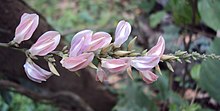|
Abrus
Abrus is a genus of flowering plants in the pea family, Fabaceae, and the only genus in the tribe Abreae. It contains 13–18 species, but is best known for a single species: jequirity (A. precatorius). The highly toxic seeds of that species are used to make jewellery.[3][4][5] Species range naturally across tropical Africa, Madagascar, the Arabian Peninsula, south and southeast Asia, southern China, New Guinea, and Australia. Some species have been introduced to the tropical Americas.[2] Species
 ReferencesWikimedia Commons has media related to Abrus.
|
||||||||||||||||||||||||||||||||||||||||||
